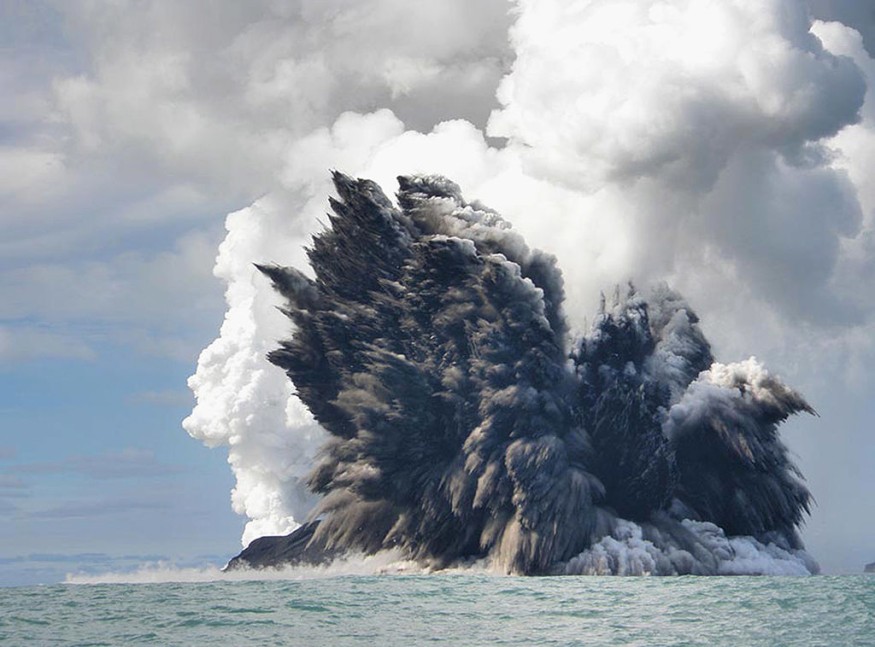The 15 January 2022 Tonga volcanic eruption was the biggest documented since the Krakatoa eruption in 1883, as per the United Nations Office for the Coordination of Humanitarian Affairs. The eruption caused tsunami waves of up to 15 meters in height to strike the west coasts of Tongatapu, 'Eua, and Ha'apai. Also, ashfall covered at least five square kilometers.
Following the eruption, limited information was available from Tonga due to damage to international and domestic underwater cables. But aside from these effects, scientists now report that an island with never before seen microbes were completely obliterated due to the volcanic eruption.

New Island Appeared After a Volcanic Eruption
A new island suddenly arose in the South Pacific in 2015, presenting a once-in-a-lifetime opportunity not just for geologists and volcanologists, but also for biologists and ecologists.
According to Science Alert, the Hunga Tonga-Hunga Ha'apai island (Hunga Tonga) was born in January 2015, nestled between two existing, uninhabited Polynesian islands that are part of the Kingdom of Tonga.
Only three volcanic islands have arisen like this in the previous 150 years and persisted for more than a few months, the most famous of which was Surtsey, which arose off the southern coast of Iceland during a four-year eruption that began in 1963.
Scientists have searched Surtsey for decades, but Hunga Tonga stands out as the only type of island of this type to originate in the era of modern satellites, opening up a whole new approach to understanding how these rocky land masses grow.
Vicki Ferrini, a geologist from Columbia University who has been examining the island with NASA researchers, said that there is a massive quantity of material from the new island and possibly even more than at Surtsey.
Microbes in the Short-Lived Island
The volcanic activity in the Pacific Ocean in 2014 and 2015 caused the Hunga Tonga-Hunga Ha'apai island to rise from the sea. Its brief seven-year existence provided scientists with a unique opportunity to study how life emerges on new land masses before it was destroyed by the disastrous Tonga eruption in 2022, as per Live Science.
Scientists discovered a strange species of microbes that presumably originated deep beneath, instead of the usual bacterium groups. The findings of the study, titled "The Early Microbial Colonizers of a Short-Lived Volcanic Island in the Kingdom of Tonga," were published in the journal mBio on January 11th.
They took 32 soil samples from various non-vegetated areas of the new island, ranging from sea level to the 394-foot-tall (120-meter) peak of the island's crater, before extracting and analyzing the DNA contained inside.
Usually, new islands are colonized by microbes found in the water or in bird droppings. However, the bacteria that ate sulfur and hydrogen sulfide gas were the most common around the volcano's cone, and they may have migrated to the island's surface via underground volcanic networks.
Dragone said that the microbes they found have characteristics associated with volcanic eruptions with lots of sulfur and hydrogen sulfide gas. These species were most similar to those found in hydrothermal vents, hot springs, and other volcanic systems.
But after the Tonga volcanic eruption in 2022, the volcano that birthed the island also became its destroyer. The eruption is said to be greater than 100 simultaneous Hiroshima bombs that sent a column of ash, island chunks, and steam to space. Due to that, the research into the island also stopped but scientists said it still gave them a blueprint for future research.
RELATED ARTICLE: Tonga Volcano Eruption in January 2022 May Cause Small, Temporary Spike in Global Warming, According to Scientists
Check out more news and information on Volcanoes in Science Times.











